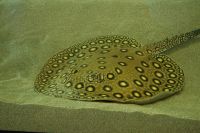Motoro Stingray (Potamotrygon motoro)
From The Aquarium Wiki
Motoro Stingray
Potamotrygon motoro
568 Litres (150 US G.)
80-100 cm (31.5-39.4")
Freshwater
5.0 - 6.5
24 -26 °C (75.2-78.8°F)
8-10 °d
1:2 M:F
8-15 years
Family
Potamotrygonidae
Contents
Additional names
- Motoro Stingray, Laticeps Stingray, Ocellate River Stingray
Additional scientific names
- Paratrygon laticeps, Potamotrygon alba, Potamotrygon circularis, Potamotrygon labradori, Potamotrygon laticeps, Potamotrygon pauckei, Taeniura motoro, Trygon garrapa, Trygon mulleri
Origin
- South America: Uruguay, Paraná-Paraguay, Orinoco, and Amazon River basins.
Sexing
- Males have claspers, which are visible from young.
Tank compatibility
- A large animal that can take smaller fish that linger on the substrate. Best kept with peaceful but robust medium-sized to larger tank mates. Aggressive fish can damage a rays disc.
Diet
- Carnivore. Almost anything that can fit into their mouths. A healthy specimen will not refuse food, especially live shrimps. Feed with meaty food such as shrimp and mussel.
Feeding regime
- As often as possible as stingrays are high-metabolic fish that are constantly moving. The ideal way is to place excess live feeds (e.g. feeder shrimps) in the tank to allow feeding at their own pace.
Environment Specifics
- Comes from the Amazon river, ideal pH would be around 6.5. Stingrays do not typically like a well lit aquarium. Stingrays spend most of the time on the riverbed where minimal light can penetrate through the murky waters of the Amazon. Therefore it is not recommended that the aquarium be brightly lit for long periods of time as this might cause a great deal of stress to the rays.
- Substrate is recommended in a stingray aquarium as rays hide in them when frightened or threatened. Substrate also provides traction when rays "walk" with their pelvic fins across aquariums. Adding substrate simulates a ray's natural habitat, the softer the better to allow for digging. However, this ultimately is personal preference. A ray will do just as well in an aquarium without substrate.
Behaviour
- In the wild, the stingray spends most of its time at the bottom of the riverbed. In captivity they will again spend most of their time on the substrate, occasionally digging for food if possible, they will swim up the sides of the tank if food is on offer.
Identification
- Typical Ray in shape with a round disc and long tail. The disc varies in colour but is generally a dark sandy brown in colour with many orange-brown spots which have thick darker borders. A marbled variant which is more striking with many brighter orange-yellow markings edged in dark brown is also available.
Pictures
Videos
External links
- Fishbase (Mirrors: Error creating thumbnail: Unable to save thumbnail to destination)

